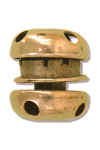


The instruments of digestive suture
Up to the 17th century, bibliographical references are found that concern four methods of suture applied to the tubular structure of digestive organs: Celso's simple suture, the suture over a vegetal or animal endoprosthesis from the Salernitanian masters, the adhesion of the injured intestine to the abdominal wall by Palfijn (1650 - 1730), de la Peyronie (17th century), Le Dran (1685-1770) and Bell (1749-1806) and invagination in transsection by Ramdohr (18th century).
Among the methods of enterorrhaphy, the one we find most interesting is the pre-Colombian and Hindu technique of fixing the ends of the intestine using the jaws of giant ants.
The most used endoprosthesis were the corncob cane (Rogério de Parma), the varnished card (Sabatier, 1732-1811), the lamb intestine (Guilherme de Salicet, 17th century) the goose trachea (School of Salerno) and the suet candle (B. Bell). In 1826, Antoine Lambert started to practise an invaginating suture, bringing the two serous layers that would later be the basis for modern gastro-intestinal surgery. The surgery would become successful ten years later, with Diffenbach (1792-1847). In the same year, Henroz demonstrated the advantages of an everted suture. Only in 1887, with Halsted (1852-1922), the role of the submucosa in the healing intestinal of digestive injuries.
The failures in digestive suture were the consequence of the lack of a specific methodology that included the surgical technique, the adopted instruments, the knowledge on the nature of the processes of healing and infection, as well as of the biological quality of the suture material.
In Portuguese literature one can find material of natural origin (interior of lamb intestine, tendons, horsehair, hair, silk, cotton, linen) and metals in the composition of suture threads. After the experiences of Lister, these materials have been prepared following the antiseptic method.
Parallel to the manual digestive suture, there have been several attempts to introduce the automatic digestive suture. The first automatic suture device that allowed accomplishing digestive circular anastomoses in a faster and more efficient way than the manual suture was the button of Murphy. There had been prior works by Denans (1826), Henroz (1826), Bonnier (1869), Sen and Abbe (1889) concerning the circular automatic suture.
From 1920 the linear automatic suture had an important development thanks to the contributions from F. Hahn (suture with thread) and mostly from H. Hultl, author of the bases of the automatic suture with staples. Aladar von Petz introduced the sliver staples and the double continuous row of staples. This was a less heavy device, which had wide surgical acceptance. Another important contribution was the adaptation of removable cartridges (H. von Seaman and Friedrich, 1934). The works led by the Experimental Institute of Scientific Research of Moscow and of the United States Surgical Corporation in the USA were also of major importance to this subject.
In Portugal the Medical School of Porto continues the research in this topic, as evidenced in the Ph.D. thesis defended by Professor Araújo Pimenta (1984).

|
Murphy's Anastomosis Button: Nickel plated steel; 20th century; 2,1x2,3x2,3cm |